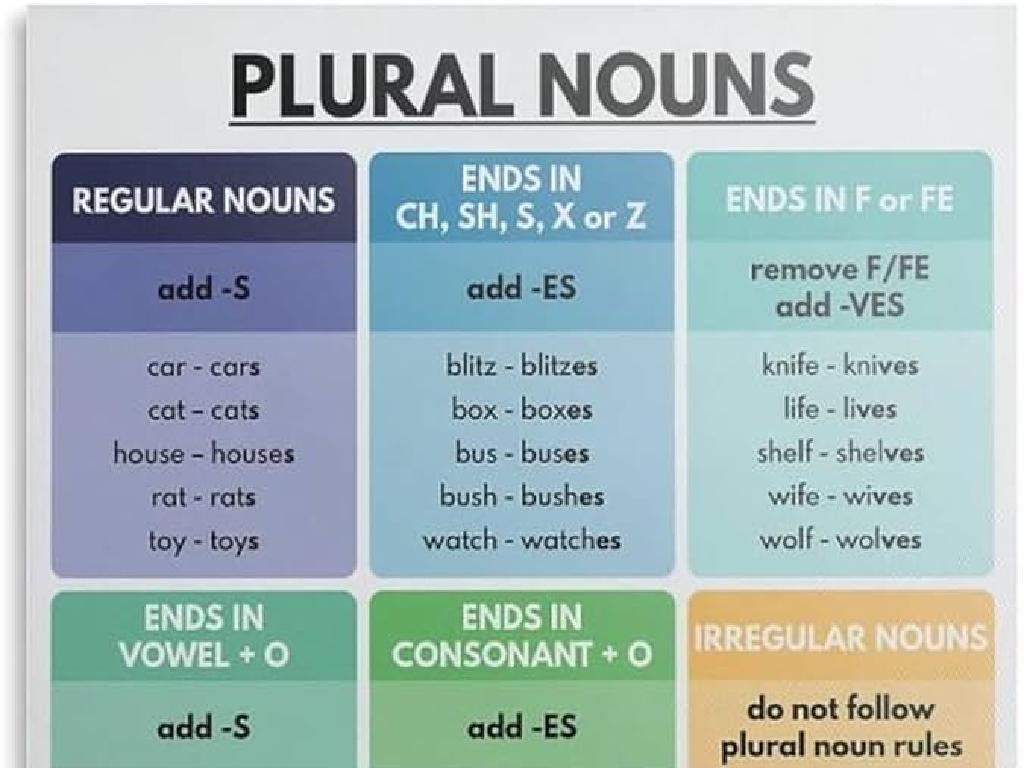Match The Quotations With Their Themes
Subject: Language arts
Grade: Eighth grade
Topic: Theme
Please LOG IN to download the presentation. Access is available to registered users only.
View More Content
Exploring Themes in Literature
– Define ‘Theme’ in literature
– A central idea or message in a story
– Uncover underlying messages
– Look for deeper meanings beyond the plot
– Common themes in stories
– Examples: courage, friendship, and love
– Analyzing themes through quotes
– Match quotes to their respective themes
|
This slide introduces the concept of ‘Theme’ which is a fundamental element in literature, representing the central idea or message that the author wishes to convey through the story. It’s crucial for students to understand that a theme is not just a single word but a statement about life or human nature that the writer shares with the reader. Often, themes are not stated directly but implied, and students must infer them by considering the characters, plot, and setting. Provide examples of common themes such as courage, loss, and friendship, and show how these themes can be reflected in various quotes from literature. Encourage students to think critically about the themes present in their own reading experiences and prepare them for activities where they will practice identifying themes by analyzing quotations.
Identifying Themes in Literature
– Finding a story’s theme
– Look for recurring patterns
– Images, ideas, or events that appear over and again may indicate the theme.
– Analyze conflict and resolution
– The way characters resolve conflicts can reveal the theme.
– Understand the author’s message
– What lesson about life or human nature is the author conveying?
|
When teaching students to identify themes, start by explaining that a theme is the central message or insight into life revealed through a story. Encourage them to look for patterns such as recurring images, ideas, or events that can signal the story’s theme. Discuss how the main conflict and its resolution often highlight the theme, and ask students to consider what the author might be trying to communicate about life or people. Use examples from familiar stories to illustrate these points. For homework, have students bring in quotations from their reading and practice matching them with identified themes.
Quotations & Themes: Making Connections
– Quotations reflect themes
– A quote’s depth is revealed when linked to the theme
– Analyze language for meaning
– Dissect words to uncover layers of meaning
– Context shapes interpretation
– Without context, quotes can lose intended significance
– Practice with examples
|
This slide aims to teach students how to connect quotations to the overarching themes of literary works. Start by explaining that themes are the central topics or messages in literature, and quotations are the specific lines that can highlight these themes. Encourage students to analyze the language used in quotations to gain insight into the deeper meaning and how it relates to the theme. Emphasize the importance of context, as the meaning of a quotation can change depending on the surrounding text and situation in the story. Provide examples of quotations and work with students to identify the themes they reflect. This will help students practice literary analysis and improve their comprehension skills.
Theme Matching Exercise
– Review quotations from texts
– Examine a list of themes
– Match quotes to themes
– Use clues within the quotes to find the theme
– Discuss matching reasoning
– Explain your choices during discussion
|
This slide is designed for an interactive class activity where students will practice matching quotations from various texts to a list of possible themes. Begin by reviewing the concept of a theme and how it represents the underlying message or main idea of a text. Provide students with examples of quotations and a list of themes. Encourage them to use context clues and their understanding of the text to match each quote to the most appropriate theme. After the matching exercise, lead a discussion where students explain their reasoning behind the matches they made. This will help them to articulate their thought process and deepen their understanding of how themes are represented in literature. Prepare to offer guidance and clarification as needed.
Group Activity: Matching Quotes to Themes
– Break into small groups
– Receive quotations and themes
– Each group gets a unique set of quotes and themes
– Discuss and match quotes to themes
– Consider what the quote is really about to find its theme
– Share your matches with the class
|
This group activity is designed to enhance students’ understanding of themes in literature by matching quotes to their corresponding themes. Divide the class into small groups to foster collaboration. Provide each group with a distinct set of quotations and a list of possible themes. Encourage discussion within the groups to determine which theme best fits each quote, considering the deeper meaning behind the words. After the activity, have each group present their matches to the class, explaining their reasoning. This will not only help students grasp the concept of themes but also develop their critical thinking and interpretative skills. Possible themes could include friendship, courage, love, and the struggle between good and evil.
Exploring Themes Through Quotations
– Groups present their matches
– Share which quotes matched which themes and why
– Discuss varying interpretations
– Understand that a quote may convey multiple themes
– Recognize themes’ subjectivity
– Themes are not always black and white; they can be debated
– Embrace diverse perspectives
|
This slide sets the stage for a class discussion where students will engage in sharing and analyzing the connections they’ve made between quotations and themes. It’s crucial to emphasize the importance of supporting their reasoning with evidence from the text. Encourage students to listen to different viewpoints and understand that themes can be interpreted in various ways, reflecting personal experiences and beliefs. The goal is to foster an environment of open dialogue and critical thinking, where students feel comfortable expressing their ideas and considering others’. This activity will help them appreciate literature’s complexity and the richness of diverse interpretations.
Reflection on the Importance of Themes
– Significance of identifying themes
Understanding themes helps grasp the deeper message of a text.
– Themes enhance reading and writing
Recognizing themes can improve comprehension and analytical skills in both reading and writing.
– Reflect on a book’s theme
Write a paragraph about a theme from your recent reading and how it relates to the story.
– Share your insights in class
|
This slide aims to prompt students to think critically about the role of themes in literature and how they contribute to a deeper understanding of the text. By identifying themes, students can connect with the material on a more meaningful level, which in turn enhances their reading comprehension and writing abilities. Encourage students to reflect on a book they’ve read recently and articulate the central theme in a short paragraph. This exercise will help them practice expressing their thoughts coherently and provide an opportunity for discussion in the next class. The teacher should be prepared to provide examples of themes and guide students on how to identify them in different genres of literature.
Homework: Connecting Quotes to Themes
– Find a thematic quote in your book
– Write a paragraph on its connection
– Explain how the quote illustrates the theme
– Reflect on the quote’s significance
– Consider what the quote reveals about the story
– Share your insights next class
|
This homework assignment is designed to help students practice identifying themes within literature and connecting specific quotations to those themes. Students should select a meaningful quote from their current reading that they feel represents a central theme of the work. They must then write a paragraph explaining how the quote connects to the theme, considering the broader implications of the quote on the story’s message. Encourage students to think critically about the text and use evidence to support their ideas. In the next class, students will have the opportunity to share their findings, fostering a collaborative learning environment where they can learn from each other’s interpretations.





